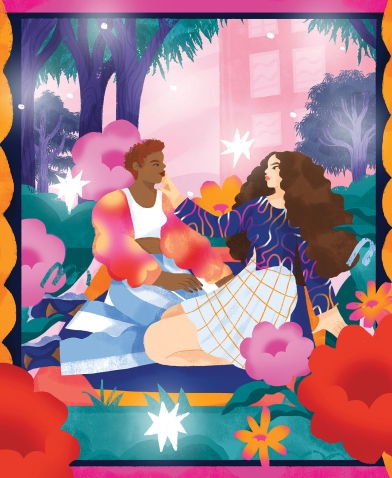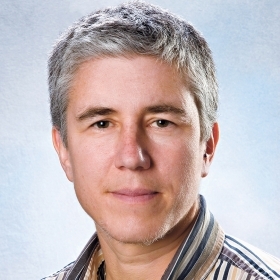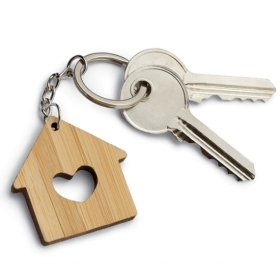Falling in love on an idyllic New England college campus has storybook qualities. But for generations, the narrative at Wellesley was a certain spin on the fairy tale: Students would find their mates off campus. Even though LGBTQ relationships likely stretch back far in the College’s history, students remained largely quiet about coupling up for probably close to a century. Today, the alumnae community includes many couples who were both Wellesley students, are comfortable being public about it, and represent a broad spectrum of sexual orientations and gender identities.
Wellesley got in touch with a handful of these double-alum couples to hear about their on-campus experiences, their lives in a rapidly changing post-college world, and what the College still means to them. Of course, this group cannot be inclusive of all experiences. But these stories illustrate some of what has changed for the College’s LGBTQ community in recent decades—and the timeless power of the Wellesley network.
Class Attraction
In a women’s studies seminar, a student across the room from Anne Ferrard-Zeiders ’90 caught her eye. When she returned to class, Ferrard-Zeiders remembered where that woman was sitting.
“I went early so that I could sit next to where she had sat the first time,” Ferrard-Zeiders recalled. That’s how she met Anna Ferrard-Zeiders ’91, and they have been together pretty much ever since. They’ve lived in Brussels, Anne’s hometown, since 1992.
When they started dating, Anne lived in the feminist co-op, Instead, and was an activist. “I was blatantly lesbian, feminist, whatever you want,” she says. “I had the label, and I was proud of it.”
Less than a decade earlier, when Janice Molloy ’84 and Susan Weinstein ’84 enrolled at Wellesley, lesbian relationships remained mostly clandestine. When Weinstein recognized that “maybe I wasn’t entirely attracted to men,” she joined a group at the Stone Center for students exploring their sexuality. “It was semi-secretive,” she says.
Molloy remembers a couple in her dorm who were seniors when she was a first-year. That relationship helped put the idea of same-sex couples on her radar. But she says only a few lesbians were truly out on campus.
“People who were brave and out were not necessarily liked for it,” Weinstein says, noting that she came from South Florida where “lesbian” was then “somewhat of a slur.” Molloy remembers one professor suggesting to her that being a lesbian would be a hurdle to certain academic or professional achievements. But on at least one occasion, faculty members joined students at the Marquee, a lesbian bar in Central Square in Cambridge, Mass. “It was a big deal” for faculty to show the students that kind of support, says Molloy. “To this day, I feel just very moved by that.”
The transition from secrecy to support was shifting on their watch. The 1980s had ushered in an evolution on campus.
“Over the course of our four years, things felt like they changed a lot,” Molloy says. She remembers that by junior year, there was an area in the Schneider Center where lesbians would openly socialize.
In the early 1990s, some students arrived at Wellesley already comfortable stating their identities as lesbian or bisexual.
“I knew of Sarah [Bay-Cheng ’96] before I met her,” says Laina Bay-Cheng ’95. Sarah and a few classmates “came to Wellesley already out,” Laina says. “It caused quite a stir.”
Sarah and Laina didn’t get together until after Laina graduated, but “we’ve been together since our first date, without any interruption,” she says.
When Melissa de la Rama ’01 and Heather Miller ’01 met in a class their senior year, they had few concerns about being out on campus. And de la Rama knew right away that Miller was “the one.”
“I was just infatuated,” de la Rama says. “I fell in love with her way before she felt anything for me.” They didn’t start dating until two years after they graduated.
As many Wellesley students became more open, attitudes toward LGBTQ people also began shifting in broader society. In recent years, student—and faculty and staff—identities include lesbian, bisexual, transgender, queer, intersex, nonbinary, and more. Still, emerging from the safety many student couples felt on campus didn’t always go smoothly.
Queer Wellesley in the World
The Bay-Chengs moved to West Lafayette, Ind., when Sarah began graduate school.
“It was explicitly unwelcoming,” Laina says. After about half a year, Sarah remembers Laina saying, “I am leaving. I would like you to come with me, but if you don’t, I am still leaving.”
They moved on, together, to the University of Michigan. Today, they live in Toronto, but they spent 10 happy years in Buffalo, N.Y., where they raised two sons.
Even the language has changed, with younger alums comfortably using the word “queer” and older alums sometimes embracing but other times eschewing the word “wife,” even in reference to a woman to whom they are legally married.
Catalina Cherny-Santos ’13 considers herself a hopeless romantic and jokes about pursuing an M.R.S. degree when she arrived at Wellesley from San Diego. When she and her wife, Rachel Cherny-Santos ’13, first started visiting Rachel’s family in Idaho, though, things felt different.
“We didn’t hold hands for the first few visits, out in public,” Catalina says. But in time, something different emerged. “I have felt more uncomfortable being Latina than I have being queer in Boise.”
They live in Southern California, and Rachel, who is a lawyer, says she makes a point to be clear about being married to a woman when the subject comes up. In the workplace, she is explicit that her marriage needs to be respected the same as any heterosexual one.
“I find that very empowering,” she says. It also sets an example that invites LGBTQ colleagues to come out. An added bonus for her, Rachel says, has been gaining more queer friends.
That’s very different from the law firm where Weinstein worked as a paralegal fresh out of Wellesley. She was closeted when, in 1986, the Supreme Court decided Bowers v. Hardwick, which upheld the right of states to have anti-sodomy laws effectively criminalizing consensual same-sex relationships. (That decision was overturned in the 2003 Lawrence v. Texas case.)
“One of the attorneys said to me, ‘Why are you so upset about this?’ and so I said to him, ‘Because I’m gay.’” She says he was completely taken aback. “It was a surprise to me that it was such a surprise to him.”
In fact, Molloy and Weinstein say to be gay in D.C. in the mid-1980s as the AIDS crisis and related activism were on the rise, “was really a wild time.” Closeted all day at work, gay men and lesbians flooded Dupont Circle at night, they say.
Marion Johnson ’09 and Veronica Cole ’09 also moved to D.C. together after graduation, but their experience was quite different.
“We went right from one super queer-friendly bubble to another,” Johnson says. Older, out LGBTQ professionals helped them navigate the post-collegiate landscape. Once Cole decided to enroll at the University of North Carolina at Chapel Hill for graduate school and the two contemplated a permanent return to Johnson’s home state, they had to confront popping that bubble.
“We would joke a lot when we were moving back, like, ‘Oh, we’re an interracial, interfaith, same-sex couple in North Carolina, we should be in a sitcom!’” Johnson says.
But while they both do work that allows them to be comfortable being out—Johnson consults on diversity, equity, and inclusion, and Cole is an assistant professor of psychology at Wake Forest University—the reality of how many people truly see them as different became clear when Johnson ran for Durham City Council in 2021.
“I came into it a little naively,” says Johnson, who lost her bid, “considering how surprised I was at how our relationship was kind of weaponized by the opposition.” Johnson never shied away from her identity, stating it clearly on her website and recognizing that their marriage license was as public as every other one.
But Anna Ferrard-Zeiders, who is an international-school principal, has always been a very private person. Although she doesn’t talk a lot about her personal life at work, she has seen, over the past two decades, the value that “out” role models can provide. “One has a responsibility to be out there showing that this is a positive thing,” she says. The climate in Brussels, she and her wife say, is not as divisive as in some U.S. communities, though they haven’t been able to connect as much with other LGBTQ families as they’ve seen some of their friends do in American cities.









We ask that those who engage in Wellesley magazine's online community act with honesty, integrity, and respect. (Remember the honor code, alums?) We reserve the right to remove comments by impersonators or comments that are not civil and relevant to the subject at hand. By posting here, you are permitting Wellesley magazine to edit and republish your comment in all media. Please remember that all posts are public.